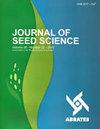熟果和干燥对豆籽品质的影响
IF 1.2
4区 农林科学
Q3 AGRONOMY
引用次数: 4
摘要
摘要/ Abstract摘要:本试验旨在研究熟果期和干燥温度对豆籽含油量和生理性能的影响。实验设计为随机分组,共4个重复。当植株达到20%、40%、60%、80%和100%棕色果实时,就可以收获。收获后,在不同温度下(30、45和60℃的自然空气和人工空气)干燥种子。对种子进行千粒重、生产力、含油量、发芽率和活力(首次发芽数和出苗数)的评价。鹰嘴豆种子(FMS Brilhante)的含油量最高,占棕色果实总量的70%。干燥温度不影响种子的含油量。为了获得最高的生理质量,应该在植物有75%到85%的棕色果实时收获克兰种子。建议在30°C和45°C下进行人工干燥,有利于生产优质种子。本文章由计算机程序翻译,如有差异,请以英文原文为准。
Maturation fruits and drying on quality of crambe seeds
Abstract: This study aimed to evaluate the effect of maturation fruit and drying temperatures stages on oil content and the physiological performance of crambe seeds. Randomized blocks were the experimental design, with four replications. Harvests occurred when the plants reached 20, 40, 60, 80 and 100% brown color fruits. After harvest, seeds were dried at different temperatures (natural and artificial air at 30, 45 and 60 °C). The seeds were evaluated for the weight of a thousand seeds, productivity, oil content, germination and vigor (count of the first germination and seedling emergence). Crambe seeds, FMS Brilhante cultivar, reach the maximum oil content with harvests made from 70% of total brown color fruits. Drying temperatures do not affect the oil content of the seeds. Harvesting crambe seed aiming at the highest physiological quality should occur when the plants have between 75 and 85% brown fruits. Artificial drying at 30 and 45 °C can be recommended for crambe seeds, favoring the production of quality seeds.
求助全文
通过发布文献求助,成功后即可免费获取论文全文。
去求助
来源期刊

Journal of Seed Science
Agricultural and Biological Sciences-Agronomy and Crop Science
CiteScore
2.00
自引率
30.00%
发文量
28
审稿时长
12 weeks
期刊介绍:
From 2017 the Journal of Seed Science (JSS) will circulate online version only.
Original scientific studies and communications, not yet published or submitted to another journal for publication and written in Portuguese or English, will be accepted for publication. For manuscripts submitted in English, the authors should provide an adequated version.
The SCIENTIFIC COMMUNICATION is a category of scientific manuscript which describes a technique, an equipment, new species or observations and surveys of limited results. It has the same scientific rigor as the “Scientific Articles” and the same value as a publication. The classification of a manuscript as a SCIENTIFIC COMMUNICATION is based on its content and scientific merit but it can be a preliminary study, simple and not definitive on a certain subject, with publication justified by its uniqueness and contribution to the area.
The Editorial Board of the JSS may invite leading authors of recognized reputation to compose specific Review Articles covering topics of their specialization that will convey to the scientific community the state-of-the-art knowledge related to the specific theme.
 求助内容:
求助内容: 应助结果提醒方式:
应助结果提醒方式:


